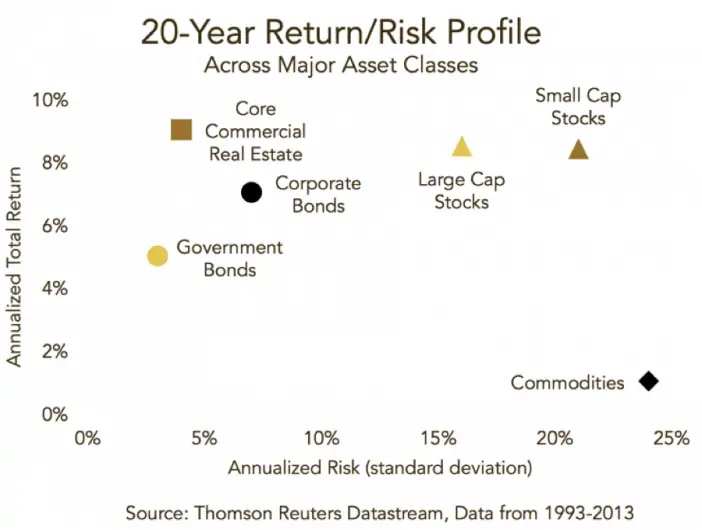While the investment with the most short-term safety may be your bank account or a stash of cash in your mattress, you are still exposed to inflationary risk or thievery (at least in the case of the “mattress account”). So even though money can legitimately be referred to as an investment, we won’t consider it on this list since, on a long enough timeline, the value of all currencies is zero. We will consider only investments that are likely to keep pace with or outpace inflation in this article
The title of this post would be more accurate if it read “The Top 3 Best Investments for Risk-Adjusted Return.” We did not use that title because many people are not familiar with the term “risk-adjusted return.”
Risk-adjusted return is defined on Investopedia as follows:
“A risk-adjusted return is a calculation of the profit or potential profit from an investment that takes into account the degree of risk that must be accepted in order to achieve it. The risk is measured in comparison to that of a virtually risk-free investment. U.S. Treasuries are usually used for comparison.“
-James Chen (Investopedia)
Now, most folks seem to be under the impression that risk and return always correlate proportionally. As in, if you want a good return, you will need to take on a proportional amount of risk. They cannot be blamed for this as most financial advisors inadvertently lead them to this assumption when they conduct a risk tolerance assessment.

The fact is that within their sphere, financial advisors are not altogether wrong. They will be investing your money into publicly-traded securities and for the most part, the public securities markets are efficient markets. What is an efficient market? Again, per Investopedia:
“Market efficiency refers to the degree to which market prices reflect all available, relevant information. If markets are efficient, then all information is already incorporated into prices, and so there is no way to “beat” the market because there are no undervalued or overvalued securities available.“
The Investopedia Team
Unless your financial advisor is conducting insider trading or investing your money into private investments not generally available to the public, he or she will probably be stuck providing you with a return on investment that carries proportional risk. Hence, the risk tolerance assessment. To make some extreme examples, someone with a substantial risk tolerance might have a heavy allocation in high-yield, risky mining stocks. In contrast, an investor with little tolerance for risk will end up with a heavy allocation into safe Treasury bonds that offer a proportionally low yield.
The good news is that we do not all live within the narrow bounds of efficient markets. If we venture into the world of inefficient markets, then we can find disproportionally high-risk, low-yield investments and low-risk, high-yield investments. Of course, we strongly prefer the latter.
“So,” you ask, “what are the best investments to maximize the return while minimizing the risk?”
Surprise! Our preferred asset classes are inside the realm of commercial real estate.
The following chart illustrates several broad asset classes’ risk and return profiles.

Notice that the data is not extraordinarily up-to-date, but please recall that real estate took a big hit in the 2008 Great Recession and only began to recover in 2012. The stock market was already on an upward trend at that point. If anything, this data representation should indicate a bias toward stocks.
Based upon this profiling, it ought to be apparent the risk/return ratio of commercial real estate investment is far more favorable than any other asset class. The average returns for core commercial real estate are nearly double those of government bonds with only a slight increase in risk, while large-cap stocks carry more than three times the risk and a slightly smaller return than commercial real estate.
So why would most people continue to invest their retirement funds in stocks? Answer: it’s easier.
For financial advisors, allocating your nest egg into Wall Street indexes with a few mouse clicks requires little effort. Outside of publicly traded REITs, commercial real estate investment is more challenging. To invest in a syndication or fund, one must seek good sponsors with good opportunities and put some time into vetting them.

The truth is that most Americans will need more savings in their retirement accounts when the time comes to live out their golden years. This is partly because, after adjustment for inflation and the administrative fees incurred upon their retirement accounts by custodians, they are lucky to be compounding at 4% in the long term.
Why on earth would one settle for this when with a little bit of education and effort, they can be achieving double-digit returns passively in commercial real estate?
But we are now on a tangent. To learn more about syndications and how to take control of your retirement accounts, please check out this article.
Without further ado, our Top 3 in no particular order:
1. Mobile Home Parks
Really? Trailer parks?
Think about it. Most of the time, the tenants own their own home but rent the pad underneath. They are less likely to default on rent than apartment dwellers because it’s a pain to move if they own a mobile home. There is very little building maintenance or other capital expenditure for the park owner. The tenants are responsible for the roofs, HVAC systems, plumbing (other than the sewer line or septic system), and other points of failure.
What happens in a deep recession? Typically, folks living in mobile home parks are retired on a fixed income, or if they are employed, they are in blue-collar jobs that are less likely to be affected by corporate downsizing.
People need a place to live, and the priority of having a roof over their heads will trump just about any other expense should they come upon financial hard times. Any sane person will cut all superfluous costs before giving up one of life’s necessities.
2. Self-Storage Facilities
This might also be a surprise to some. Our thesis is this: people (especially North American people) are attached to their stuff. In good times, they will accumulate things beyond the storage capacity of their house or apartment, and most will be sufficiently attached to the superfluous stuff to pay the small cost of a storage unit in which to park it.
In a recession, when many must downsize to smaller housing or move in with family, what do they do with their excess stuff? You guessed it. That’s why self-storage performs even better in an economic downturn.
Furthermore, self-storage has less management complexity (and, thus, less risk) than other real estate asset types. Tenants often pay for several months at a time. If someone needs to be evicted, it’s as simple as locking their unit and auctioning the contents. Evicted tenants do not have the opportunity to trash the unit on their way out, either, since the unit is locked up after a rent default. Contrast this to residential rentals, where cumbersome tenant protections have been the bane of many a landlord career.

3. Multifamily Apartment Complexes
Like mobile home parks, apartment complexes have the advantage of providing people with one of life’s necessities: shelter. No matter what happens, people will always need a roof over their heads and will somehow find a way to pay for it.
Compared to the above two asset types, there is additional management complexity and, thus, more risk in the multifamily space. But with that complexity also comes more opportunity to add value. There are countless ways to add value to mobile home parks and self-storage, and multifamily assets have plenty of levers to pull to increase the yield.
Also, statistically, apartment buildings are far less likely to be foreclosed upon than portfolios of single-family houses. This is partly because they are valued based upon a multiple of NOI (similar to a business) rather than the fickleness of the comparable sales approach.
Conclusion
There you have it: our preferred asset types for above-average returns with the highest margin of safety. In inefficient markets such as real estate, risk and return are not proportional, and therein lies the potential to achieve the best risk-adjusted returns of any asset class.
Within the world of real estate, we posit that three asset classes stand out in terms of risk-adjusted return. These are mobile home parks, self-storage, and apartment complexes.
Interested in investing passively in commercial real estate? We love to provide our investors solid returns while protecting their principal and providing some of the most desirable tax advantages. Schedule a no-pressure call with us today to see how we can help you achieve your financial goals.
Disclaimer: The opinions conveyed in this article are provided for educational purposes only and should not be interpreted as an offer to buy or sell any securities or to make or contemplate any investment.


One thought on “The Top 3 Safest Investments”
Comments are closed.